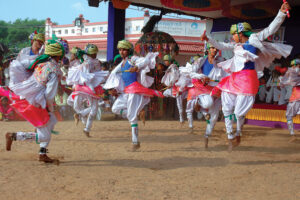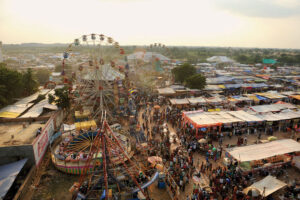At the Tarnetar Mela an age-old matchmaking tradition is practised even today.
All traffic from thanghadh seemed to be moving in just one direction, people were packed like sardines on anything with four wheels including the popular local mode of travel, the chakada, a strange contraption consisting of the engine of an Enfield motorcycle attached to a colourfully decorated trailer. Bullock carts and camels plodded along at a leisurely pace among the vehicles, while horses cavorted just off the road.
 They were circumventing something and on drawing closer, I saw what it was—innumerable ‘cammodes’ or English toilet seats. These artefacts might be a surprise for outsiders but is all too natural once one comes to know the background of the area. Thanghadh, a small town in Surendranagar district in Gujarat, has a huge industry in ceramics.
They were circumventing something and on drawing closer, I saw what it was—innumerable ‘cammodes’ or English toilet seats. These artefacts might be a surprise for outsiders but is all too natural once one comes to know the background of the area. Thanghadh, a small town in Surendranagar district in Gujarat, has a huge industry in ceramics.
Ingenious villagers use the discarded ‘cammodes’ to build their compound walls, a bizarre architectural marvel.
The Mela is about 10 kilometres away from the town but all along the length of that route, the revelries had already begun. Loud joyous cries of “Halo, halo, mela maa” (Come on to the fair) interspersed the cacophony of honks. The actual sight still caught me unawares.
Spread over a mammoth open ground, it easily dwarfed any other fair I had been to. Three towering sky-high giant wheels with white clouds peppered above them lorded over the grounds.
All around, there were spectacles like the maut ka kuva (well of death) where stunt motorcylists displayed their daredevilry in a mini amphitheatre; rural Olympics with bullock cart and horse races (the pride of an entire village being put on the finishing line); more games and athletic events; pulsating folk dances; stalls selling everything from utensils to handicrafts to tattoos. It was like a scene from a big Bollywood blockbuster, with something of interest for everyone.
Tens of thousands flock here each year during the Hindu calendar dates of Bhadarva Sud – 4th, 5th and 6th (falling in the month of either August or September). The fair is a microcosm of the tribal heritage of Saurashtra and the local gathering comprises castes and communities of the region like the Kolis, Rabaris, Bharwads, Khants, Kanbis, Kathis, Charans, and the Desi-Rabaris.
 Over the years the fair has also been attracting large numbers of domestic and international tourists on account of its unique central purpose—matchmaking.
Over the years the fair has also been attracting large numbers of domestic and international tourists on account of its unique central purpose—matchmaking.
“Tamare parannvu chhe? Khali chokari batavi do, gada ma nakhi ne bhagadi jayiye” (Do you want to get married? Just point out the girl, we will put her in a bullock cart and whisk her away), one of the ‘bharwads’ or shepherds, said with a twinkle in his eye. He twirled his long moustache, his rugged face crinkling into a big smile. Could it really be so simple? And as if following my train of thought, he got off his bullock cart and asked “Aamathi kai gami?” (Which one of these do you fancy?).
Without waiting for an answer, he began walking towards a group of giggling young women close by, all dressed up in their finery of open-backed cholis, bright ghagras and a collection of beautiful ornaments and trinkets, to find me a suitable bride.
Surely, he must be joking, I thought. Or was he not? In any case, I didn’t wait to find out and went in search for my friend, who enraptured by some coy village belles, was trying to capture them on frame. He was oblivious to the suspicious looks of the well-built men-folk accompanying the girls. I dragged him into the safety of the crowd.
The fair goes on for three days on the grounds of the famous Trinetreshwar Mahadev temple. Locals say that it started about 250 years ago and is a celebration of Draupadi’s swayamvar, the Mahabharata episode in which Arjun won her hand in marriage. The temple ground, in the mela’s legend, is believed to be the venue of the swayamvar.
In practice, even today, when matchmaking has moved online, and when partners and dates are found on platforms like Tinder and Hinder, Tarnetar Fair remains as a remnant of what was once the mainstream.
According to custom, matches among the various castes are fixed in childhood, though the bride today steps into her in-laws’ house only after she is 18 years old. The colourful and lavishly decorated chhatris, or umbrellas, that I spied all around at the fair were not just ornamentation but also a signal.
This was the tool through which, earlier, the bride would know who her groom was. He would tie the kerchief sent by her to the umbrella. At the fair, she would recognise it and get the first glimpse of the boy to whom she had been married off as a child. She would then approach him and the couple seeking an opportunity would get away from the forbidding glances of elders and spend some time alone. If the groom was impatient, he would elope with her without further ado.
Times have changed but still there are a large number of youngsters who still mimic the practice and strut around the fair proudly dressed in their traditional attire, bedecked with huge gold earrings, necklaces and silver chains around their waist. They hold their chhatris high, either searching for brides or hoping to find one. The umbrellas are a status symbol of their bachelorhood. These young men labour for nearly a year before the fair to decorate them with elaborate embroidery design, adorned with beads, mirrors etc. and small colourful handkerchiefs all around the edge. They match it by donning colourful dhotis and headgear. The custom of embroidering the chattaris is believed to have been started by the Koli community of Saurashtra. All in all, a striking matrimony advert, I felt.
It can be a bit unsettling and overwhelming to be surrounded by the sea of humanity but the joyous fervour is infectious—men and women jumping, twirling and dancing with ease, the beat so catchy that it is hard to stand still. Many bystanders can’t restrain themselves from joining the group of dancers. The beats continue to resound throughout the day as dancers flit from one group to another, performing various folk dances. For the hardy tribal folk, dancing is an expression of joy and integral to their lives.
So it’s no surprise to see groups of men and women break out into impromptu dance all over the fair ground. The sight of them twirling is mesmerising. Along with dandiya raas, and garba, which are popular across the state, one can also witness other folk dances like huddo, rasadas and rahado. Huddo, a dance unique to the shepherd community, is performed by two rows of men vigorously clapping their hands similar to high fives in tune to a fast beat.
The form is inspired from the scene of fighting rams. In Rasadas, a group of women, sometimes as many as 100 to 200, dance in a single circle to the accompaniment of four drums and double flutes. Rabari women of nearby Zalawad showcase a Rahado, again a circular dance. Interestingly their costume indicates their marital status; a black zimi (skirt) means the woman is married and a red one means she is unmarried, probably seeking a husband, yet another sign for interested bachelors in the crowd.
Apart from the match making, the Trineteshwar temple itself is a significant feature of the fair. Each year the fair is inaugurated with the hoisting of a flag on the dome of the temple. The flag is ceremoniously carried in a procession comprising traditionally decorated bullock carts and horse carts accompanied by folks from nearby villages and led by the mahant (head priest) of Paliyad.
Religious rituals are also performed at the temple during the three-day fair with sages of Margi Panth singing melodious ‘bhajans’ of Lord Shiva.
The temple is an important pilgrimage centre and people from far and wide throng to seek the Lord’s blessings. During the fair many tribal men and women do so to find a suitable match. After all, even after all the effort they take at the Mela, for the most important decision of one’s life, it helps to have some divine assistance. #hydtravel #hydnews

